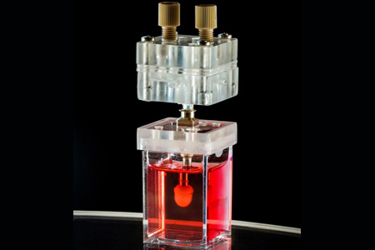Heart-In-A-Jar Organ Model Earns Regulatory Respect After 25 Years In The Making
A conversation with Ronald Li, Ph.D., CEO and cofounder of Medera, and Kevin Costa, Ph.D., cofounder of Novoheart

More than 92% of drugs that clear animal testing end up failing in clinical trials. Many of those drugs that initially get the green light from animal models have unexpected toxicity in humans. The fail rate means that pharma is wasting time and money — not to mention needlessly putting human well-being at risk.
Just a few weeks ago, the FDA took the issue head-on in a focused workshop, together with NIH and global regulators. FDA Commissioner Marty Makary, MD, MPH, heralded alternative testing methods as capable of delivering drugs faster, reducing R&D costs, encouraging more innovation (reducing capital requirement), and treating animals more humanely. This move away from animal testing and toward new approach methodologies (NAMs), such as organoids and computational simulations, reflects the principles of the FDA Modernization Act 2.0, which removed the requirement that drugs be tested in animals before human trials.
The approach, however, has long been advocated by researchers Ronald Li and Kevin Costa, cofounders of Medera’s Novoheart. For more than 25 years, the two have been building what’s now known as heart-in-a-jar technology — a tiny human ticker primed for testing investigational drugs.
The timing is fortuitous, though the path has not been without challenges. Here, Li and Costa recount their efforts, describe the potential for mini organs like their heart-in-a-jar to replace animal testing in preclinical studies, and discuss their current use in clinical trials.
Drugs Discovery Online: The heart-in-a-jar technology has been available for nearly a decade. Take us back to the beginning. Why did you decide to develop an alternative testing method?
Ronald Li, Ph.D.: Novoheart, a Medera subsidiary, leads our efforts in organ engineering, while our other division, Sardocor, focuses on applying these platforms to develop gene therapies for heart disease. In brief, the company group has been around for 10 years, but Kevin and I have been working on the very same topic for over 25 years, initially in the academic setting. It began as just a concept on a whiteboard while we were at Johns Hopkins, driven by scientific frustration with the drug screening process. We knew that many promising drug candidates passed animal testing only to fail in human trials, often as a result of unexpected cardiotoxicity or lack of efficacy. But we always knew that the issue wasn't always just about the compound itself, it was the models being used to screen the compounds.
Animal hearts differ dramatically from human hearts. For example, rodents have heart rates of 600 beats per minute versus 70 beats per minute in humans. So, we set out to build a system to replicate human-specific cardiac function. The first breakthrough came with the development of the first-ever genetically engineered human heart cells around the beginning of the millennium. Then, we put these single cells together for the first time as biological pacemakers to replace electronic pacemakers. From there, we developed ways to mass-produce single cardiomyocytes and later put them together as three-dimensional functional tissues, which in turn led to the world's first mini hearts, fully capable of ejecting fluid.
Kevin Costa, Ph.D.: The dream of being able to make these human heart pumps was really combining my rodent-based tissue engineering research with some of the pioneering work that Ron was doing on human heart cells. Being able to now make these three-dimensional engineered cardiac tissues out of human cells really brought the capability of having human mini hearts in small bioreactor “jars” in the laboratory, which was a major game changer.
Drugs Discovery Online: If I were to look at this heart-in-a-jar, what would I be looking at? And then how plentiful are they? Are they scalable?
Li: It's literally a beating heart chamber sitting in a jar. It takes about a week to convert human pluripotent stem cells into beating cardiomyocytes, which become fundamental building blocks for a working heart. The fabrication takes about another week, but we can make as many as we need and we never have to come back to a donor again.
And because they are coming from a donor, they are genetically and immunologically identical to that person. You've got only one heart sitting in your chest, and you don't want to use it for testing unknown drugs. So, we can use these cardiac surrogates to represent your heart to test new drugs. We can optimize the dosages, all sort of things that you don't want to do with your own body.
So, it’s not just a heart-in-a-jar. It’s a smarter way to predict human outcomes. We’re not just replacing animals; we’re replacing guesswork.
Costa: And the size is like a fingertip. We've reduced the size to the minimum that's necessary to get the information we need. There are a couple of billion cells in a human heart. The mini hearts take about 10 million cells to make. A eureka moment was when we transferred one of the early prototypes into a measuring system, and it got loose and started swimming around in the fluid. And we were like, “Wow! This is really pumping! This is really doing what a heart needs to do.”
Drugs Discovery Online: What are some of the challenges that you faced in developing the heart-in-a-jar?
Li: Every part of the journey was a challenge. There were no off-the-shelf tools or playbooks whatsoever. We had to develop and optimize everything in-house from scratch: differentiation protocols, tissue engineering techniques, media scaffolds, hardware and software, and things like that.
Talent was a major hurdle as well. It was a hurdle back then, and it's still the hurdle today. Very few scientists had the cross-disciplinary training needed to engineer cells, let alone tissues, so building that team took time and tenacity. People were doing things independently back then and people still are. Everyone was working in his or her own lab in silos.
The first time we were able to make human heart cells from the lab from scratch, the yield was only about 0.2%, 0.3%, and it took us about 10 years to scale that to more than 90%. It is absolutely critical to be able to mass-produce high-quality cardiomyocytes. Without enough cells, there is no tissue engineering.
And of course, gaining regulatory and industry acceptance required data, a lot of it. And we spent years generating very rigorous evidence to validate our platform. Even though we were able to make the first heart — and that was very exciting — a bunch of questions immediately came along. How similar is the mini heart to the native heart? How about the physiology? How about the pharmacological responses?
Over the years, we had contributed to FDA and NIH study sessions, consortia like CIPA (Comprehensive in Vitro Proarrhythmia Assay) and HESI (Health and Environmental Sciences Institute). That's why the FDA Modernization Act 2.0 felt so meaningful to us. It's a story that we've been preaching for over 20 years. Finally, our work had not only scientific merit but also regulatory legitimacy. Fast forwarding to today, our mini-heart technology has also led to our own FDA clearances for IND and Fast Track designation for an ongoing first-in-human cardiac gene therapy clinical trial for heart failure.
Drugs Discovery Online: What are the differences from or successes over an animal model?
Li: In the Cardiac Arrhythmia Suppression Trial (CAST) study, animal models showed no issues with the drugs that were developed as anti-arrhythmics, but when they advanced into clinical trials the same drugs started hurting patients by, ironically, causing lethal cardiac arrhythmias. Much later, we were quite excited when we demonstrated that our mini heart platform detected what animal models missed, and the human trial data confirmed our predictions. That study changed everything, and it proved that our system could de-risk drug development programs more reliably than traditional animal models.
Costa: CAST showed that animal models missed lethal side effects — patients died. In contrast, our mini hearts did detect the same arrhythmias in retrospective testing. It was a turning point: proof that our human-based model could have saved lives and prevented clinical trial failure.
Drugs Discovery Online: Do you think pharma will start looking to revive drugs that didn't initially pass muster by retesting them with technologies like yours?
Li: Absolutely. Technology like ours can not only discover novel drugs but also resurrect some of the drugs that might have failed previously, especially drugs that passed initial safety but haven't been approved for efficacy.
Costa: We built the world’s first human mini heart model of HFpEF — a common but poorly understood type of heart failure with no good animal models. This is not a genetic disease. Diseases with a genetic basis are actually easier to replicate in these engineered tissue models because the cells themselves are abnormal, so naturally they're causing heart abnormalities in patients, and they cause abnormal mini hearts as well.
But HFpEF is more lifestyle focused. So, we identified some factors to make mini hearts act like heart failure hearts. We compared them genetically with the transcriptomic signatures from patients with HFpEF, identified some key genes that were downregulated — one in particular is a calcium handling gene — and showed that a restorative gene therapy could correct symptoms of HFpEF. Basically, we could make the failing mini hearts function normally again.
This was part of a data package that we included in an IND application to the FDA and eventually in a Fast Track designation as well; it’s the first of its kind based on these in vitro models. Regulators commented that using the clinical drug in our in vitro system – it was the same compound that's being tested in patients – gave it the validity that they were looking for. The clinical trial is now completing Phase 1/2a and moving toward Phase 2b.
This isn’t just a lab tool. We’ve used our mini heart to develop and validate an actual gene therapy for HFpEF, a disease with no reliable animal model and no approved treatment.
Drugs Discovery Online: What role might a mini heart have in precision medicine? Could you take specific cells from a specific person with a disease and make something especially for them?
Li: It's absolutely doable. While patient-specific hearts remain costly, the technology is viable today — and we expect costs to decline. In the meantime, disease- and ethnicity-specific models offer a powerful path toward equitable precision medicine. For example, Brugada syndrome, a form of electrical disturbance of the heart, is more commonly seen in Asia – you don't really see that in Caucasians. By contrast, Long QT syndrome is seen in Caucasians but not in Asians.
As regulators and the industry shift toward NAMs, we believe platforms like ours won’t just complement drug development — they’ll become the new standard.
Costa: And the costs will come down. Novoheart doesn't just develop the biologics but also the hardware and software that supports these engineered tissues. We develop these automated systems using machine learning to analyze the data and predict drug classes and things like that. Part of that process involves miniaturizing and increasing the throughput. So, we're scaling these mini hearts, doing 24-well and 96-well plate versions. The questions from drug developers shifted from “how well does it work?” to “how do we scale it up?” So, this is what we've been focusing on.
Drugs Discovery Online: Understanding that the FDA's desire is for pharmaceutical companies to use NAMs, what advice do you have for those exploring new non-animal models?
Li: The best method is the one that gives you new insight — reliably, reproducibly, and in a way that is translatable to human clinical outcomes. That's what we’re all ultimately looking for. Choose platforms with validation in human trials or regulatory discussions. Scalability, reproducibility, disease relevance — these are nonnegotiable.
And the best partner in this space combines cutting-edge innovation with scientific discipline and, very importantly, practicality. Are they reproducible? What is the throughput? What is the accuracy? What is the sensitivity? Yes, you can build a prototype, but can the prototype be mass-produced and provide reproducible data with good statistical confidence? And finally, don't be afraid to reach out and ask people around you.
Costa: It’s about choosing the right tool for the question, for the stage of development that you're at. As long as you have data that shows this is effective and predictive, that's the bottom line. I think there’s an inclination in engineers, in particular, to add complexity, to make it more exciting, more novel. You have to really ask yourself if it's getting you toward a goal. Sometimes you just have to say, “That might be cool, but is it really helpful?” We are excited that the heart in a jar is proving to be really helpful. And we’re just scratching the surface. The next few years will show just how far this technology can go.
About The Experts
 Ronald Li, Ph.D., is the CEO and cofounder of Medera and an internationally recognized expert in cardiac electrophysiology and human heart tissue engineering, with 200+ publications.
Ronald Li, Ph.D., is the CEO and cofounder of Medera and an internationally recognized expert in cardiac electrophysiology and human heart tissue engineering, with 200+ publications.
 Kevin D. Costa, Ph.D., is the scientific cofounder of Novoheart and a biomedical engineering expert specializing in cardiac tissue engineering.
Kevin D. Costa, Ph.D., is the scientific cofounder of Novoheart and a biomedical engineering expert specializing in cardiac tissue engineering.
